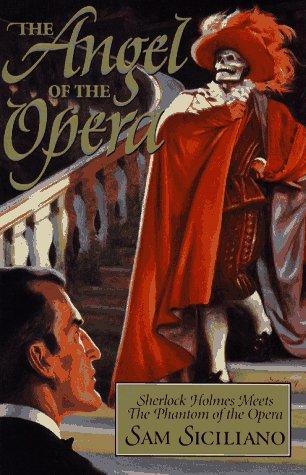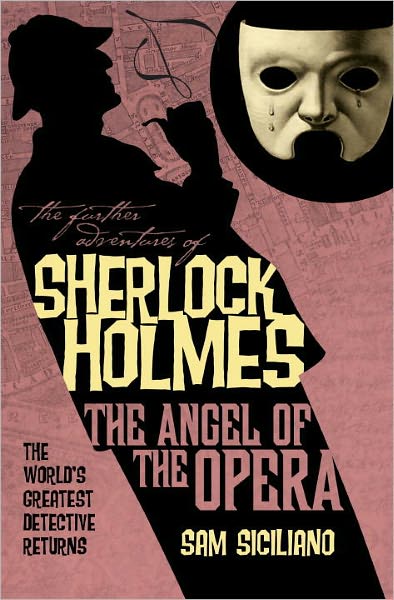Sam Siciliano; Publisher: Titan Books (March 2011)
“Watson was accurate in his physical description of Holmes, but Sydney Paget’s [sic] drawings were highly idealized. My cousin was not so handsome, nor did he resemble the actor Basil Rathbone! His hawkish nose threw his face off balance; his hair began to recede in his late thirties; his lips were thin; and he had a weak chin. All in all, he had a certain grotesque quality, his skeletal frame, his blazing eyes, pale complexion, and large nose all contributing to the impression. My frankness here may seem unkind, but his heart and his mind were what made Sherlock Holmes great” (8).
What happens to a character that becomes larger than life? Is there a next chapter in the story, or does the simple fact that the character tends to dominate everything mean that he has come to the end of his literary journey? When considering Sherlock Holmes, it appears that, more and more often, authors want to stretch the limits of his oft-vaunted deductive abilities, place him in situations that are beyond belief or description, or fill in the gaps in the Detective’s personality or private history. Moreover, many authors have brought Holmes face-to-face with other larger than life fictional characters or historical figures—either having them work in tandem, or pitting them against each other. Over the years, Sherlock Holmes has met or worked with—in various capacities—Count Dracula (and Bram Stoker), Dr. Jekyll (and Mr. Hyde), Sigmund Freud, George Bernard Shaw, Oscar Wilde, Theodore Roosevelt, Lillie Langtry, and H.G. Wells. And that’s an abbreviated list.
I have explained elsewhere about my personal affinity for a Sherlock Holmes meets the Phantom of the Opera story. For purely sentimental reasons, I am quite drawn to them. And The Angel of the Opera: Sherlock Holmes Meets the Phantom of the Opera, by Sam Siciliano, promised to a very different tale from the outset. To begin with, the novel is not narrated by Dr. Watson, but is instead told by Holmes’s cousin, Dr. Henry Vernier. The events take place in the summer of 1891, during the time that most know as the “Great Hiatus,” but as Vernier explains, Holmes was not pretending to be dead, nor had there ever been a “Professor Moriarty.” Instead, Holmes and Watson had fallen out, and were estranged for several years. The events of “The Final Problem,” and “The Empty House,” were contrived by Watson, Vernier maintains, to disguise their alienation. Dr. Vernier does not care much at all for Watson, and he makes no secret of that fact. He is, however, the young doctor who purchases Watson’s practice in “The Norwood Builder,” allowing Watson to return to Baker Street.
While a Sherlock Holmes seen through the eyes of his cousin is not dramatically different from the one that Dr. Watson shares with the reader, he is subtly more emotive. The theatrical backdrop of Siciliano’s novel brings Holmes’s musical spirit out to the forefront; he is somehow both more sensitive and more isolated. Holmes cares deeply for his cousin and his well-being (physical and emotional), and despite their supposed disagreement (which is never elaborated upon), there are instances where Holmes indicates that he misses Watson and still values his friendship. From the early paragraph quoted above, it is clear that Vernier recognized many similarities, on many levels, between his cousin and the famous opera ghost, and he wants his reader to do the same. And if Vernier believed that Sidney Paget’s illustrations of Sherlock Holmes were highly idealized, one must wonder what he thought of Frederic Dorr Steele’s drawings!
The cast of characters occupying Siciliano’s own version of the Opera Garnier seems to find a comfortable median between the portrayals in Gaston Leroux’s original novel, and those in Andrew Lloyd Webber’s popular musical. Christine Daaé is flighty and uncertain, really more of a girl than a woman, but shows moments of strength and determination. Holmes knows from the start that Christine will choose the dashing Raoul over the disfigured Phantom, but: “She will make the Viscount sweat, I can tell you that” (156). As for the Viscount, he is whiny and petulant—a spoiled brat trying to occupy the role of a dashing romantic hero. He is unlikeable in almost every way, and Holmes has little patience for his behavior.
And as for Erik, the phantom, again Siciliano has found a neat balance. His Erik is equal parts the psychotic killer of Leroux’s invention, and the misunderstood romantic soul of Webber’s musical. That Holmes sympathizes and identifies with Erik is abundantly clear; as Holmes and Vernier stand outside the door to Erik’s lair, Holmes says:
“You would not care to reconsider and let us in for a chat? We have much to discuss, and I would give anything to hear you play the violin again.” Gradually his smile faded away. “The managers are buffoons, and the Viscount is a young puppy with less breeding than any of his dogs. I doubt you will believe me, but I would like to help you. I would not willingly bring harm to you. Perhaps a part of you is deformed, twisted, corrupted, and I do not refer only to your face. Still, there should be a place in the world for a man such as you. Your genius is wasted down here, wasted. Can the rats appreciate your music? Can even Christine Daaé? Please open the door” (182).
The comparisons between Sherlock Holmes and the Phantom of Opera grow a bit obvious and tiresome after awhile. At points, the story starts to seem like one long metaphor for Holmes’s own isolation, misanthropy, and the burden of his own genius. But Henry Vernier makes for a refreshing and candid narrator, despite his own personal opinions about Dr. Watson. He sees Sherlock Holmes in a different way, and likewise Holmes shares a different side of himself to his cousin. Vernier’s view of Holmes is more flawed, more susceptible to weakness; and nowhere is this clearer than when Holmes stands gasping for breath at the top of the opera house, struggling to speak after having run the stairs to roof: “Henry, perhaps I should give up tobacco” (156). Also of note: Toby, the famous bloodhound from The Sign of Four, makes a light-hearted and well-timed appearance (amusingly the reader learns that Watson had misidentified Toby’s gender and she is actually un chien de belle fille).
Gaston Leroux may have been most famous for penning The Phantom of the Opera, but he also wrote a series of detective stories featuring an investigator named Joseph Rouletabille. Leroux obviously had an appreciation for the form of detective fiction, and the reader might wonder how he would have received seeing one his creations face-to-face with the world’s first consulting detective. For those familiar with the plot of The Phantom of the Opera (in any of its many forms), there will not be a lot of surprises in the way of plot, or action. There is plenty of the expected singing, a crashing chandelier, and oodles of passionate, romantic sacrifice. But it is ultimately Sherlock Holmes—as is so often his wont—who is the most surprising element in this story. His actions are often unpredictable, his alliances and sympathies are sometimes murky, and his motivations are complex—but he’s always identifiable, always recognizable, and always very much himself.
oOo
There’s a new blog contest open! Share your thoughts about the Master Detective on screen, and you can win the original canon on audiobook, read by the incomparable Edward Hardwicke. Contest is open until 11:59p.m., on Saturday, September 24. Details here.
“Better Holmes & Gardens” now has its own Facebook page. Join by “Liking” the page here, and receive all the latest updates, news, and Sherlockian tidbits.



Bravo! Always a treat when two favorite characters meet. As usual you consider the subtle possibilities that the author must have considered in bringing them together and how solutions were found for them in the particular Holmesian offering. A great recommendation that Sherlock is the most surprising element, yet "always identifiable, always recognizable, and always very much himself."
ReplyDelete